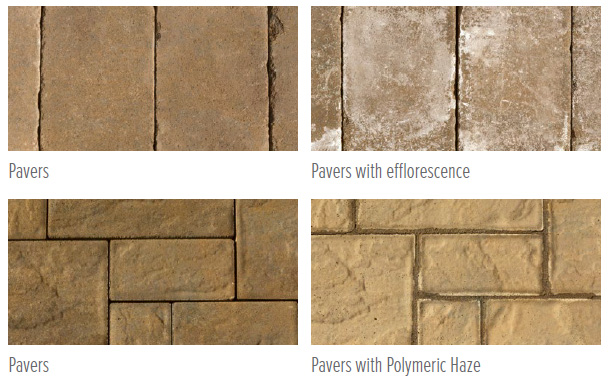MANAGING EFFLORESCENCE
Congratulations! You have recently improved your property with strong, colorful and attractive Cambridge pavingstones. As a proud owner, you have invested in a longlasting, durable, yet flexible pavement that adds value to your real estate. A truly beautiful yet practical pavement graces your property. If your project is just about to begin, you can anticipate enhancing your property with the best paving system for your money.
WHAT IS EFFLORESCENCE?
There is a chance that after a few weeks or months pass, a white haze may appear on the surface of the pavers. This is known as efflorescence. It may appear randomly or in certain areas, and will be more pronounced on dark colored pavers. The white haze may give the impression that the color of the pavers is fading. When wet, the white disappears and the color of the pavers is enhanced. When they dry, the white haze reappears.
EFFLORESCENCE IS COMPLETELY NATURAL AND WILL DISAPPEAR WITH TIME
There is no reason to be concerned that your pavers are damaged or defective. The concrete pavers are going through a natural process. It is a condition that occurs in all cement-based products, as well as in many other paving products. The condition will usually correct itself with time and exposure to the elements.
WHEN WILL EFFLORESCENCE STOP?
When the supply of calcium hydroxide is exhausted. If you live in an area of frequent rain and sunny days, efflorescence and its passing may occur quickly. The process may take much longer in drier climates.
WILL IT GO AWAY NATURALLY?
Since many factors are involved in its formation, it is difficult to determine when efflorescence will stop. Just as it appears naturally, efflorescence will eventually disappear. Over time, rainwater can wash and wear it away. In urban areas with acidic rainfall, efflorescence may go away faster than in rural areas.
CAN IT BE REMOVED WITHOUT THE WAIT??
Yes, efflorescence may be cleaned with commerically available cleaners formulated
specifically for concrete pavers. Cleaning should be performed immediately after
efflorescence has appeared. It may reappear as long as the chemical reaction
continues and cleaning may need to be done until efflorescence has stopped.
Most cleaners contain acid and detergents, so be sure to follow all label directions
and environmental regulations. Careless or improper cleaning can result in injury,
damage, and discoloration to the surface of the concrete pavers. Always conduct a
test in a small, inconspicuous area before applying any cleaner to the entire area of
concrete pavers. After cleaning, the pavers should
THE CHEMISTRY OF EFFLORESCENCE
All concrete products contain cement which produces lime or water soluble calcium oxide. Lime can also be in the bedding sand, aggregate base materials, or soil. Although concrete pavers are solid, strong, and very dense, they contain millions of microscopic capillaries that run from the interior to the surface. Moisture from rain, sprinkler systems, underground sources, poor site drainage, or dew enters these microscopic capillaries. Calcium oxide inside the paver reacts with the water in the capillaries and forms calcium hydroxide. This rises to the surface, reacts with the carbon dioxide in the air, and forms a white haze of calcium carbonate. When moisture on the surface evaporates, the white haze of efflorescence becomes visible.



Efflorescence emerged from pores within a magnified area of a concrete paver. The calcium has been carried to the surface by water.
ELIMINATING EFFLORESCENCE
Most producers of pavers put chemical additives in the concrete to reduce the likelihood of efflorescence. Completely eliminating the chance of efflorescence, however, isn't possible because it's a natural byproduct of hardened concrete. It will stop when no more calcium hydroxide is available to move to the surface. There are cleaners available that can remove efflorescence. These will enhance the natural beauty of your concrete paver project. Consult your paver supplier to find an appropriate cleaner.
POLYMERIC HAZE
Polymeric haze from the use of polymeric joint sand may appear on your concrete products if the sand was not removed from the surface of the paver properly. This does not affect the integrity of the product or your installation. The hazing will weather away naturally with time and rain or it can be removed with a specialized cleaner. You are advised to contact your contractor. Cambridge Pavers, Inc. accepts no responsibility or liability for this occurrence.
For more information, visit www.icpi.org
